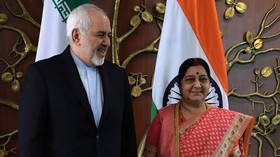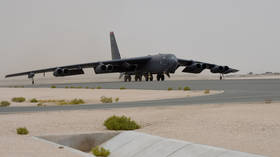FM Zarif arrives in India as US-Iran tensions flare up in Gulf

Iran’s Foreign Minister Mohammad Javad Zarif has visited India as both powers seek to cope with the impact of sweeping US sanctions aimed at cutting Iranian oil exports to zero.
Zarif arrived in New Delhi on Tuesday to meet with his Indian counterpart Sushma Swaraj. “India is one of our most important partners, economic, political and regional,” the Iranian foreign minister said ahead of the talks.
The visit comes weeks after the US suspended temporary six-month waivers that had allowed several countries, including India, to continue buying Iranian oil without facing America’s penalties. Unsurprisingly, the issue of sanctions is expected to be top of the meeting’s agenda.
Also on rt.com US plans to deploy 120,000 troops in Middle East to counter Iran – reportIndia was Iran’s second most important customer after China, but it put a halt to imports after the waivers expired in early May. New Delhi said at the time that it was prepared to deal with the damage inflicted by the US sanctions.
Should India decide to resume trade with Iran despite the US sanctions, it would be expected to switch from the dollar to the rupee for payments, according to Alexey Kupriyanov, a research fellow at Russia’s IMEMO institute.
The next step would be to start making payments through local commercial banks in India. “It’s a scheme that is already working, and is likely to develop further,” Kupriyanov said. However, the analyst believes India expects to be granted new waivers, obviating the need for such workarounds.
Ultimately, India’s actions will be decided after the current elections, which are set to conclude in May, Kupriyanov said. The outcome of the polls will decide whether New Delhi opts to antagonize Washington by taking measures to trade with Iran.
“If [current Prime Minister Narendra] Modi takes the lead, he is more inclined to take drastic steps… if he has to form a coalition government, or if the [opposition party] Indian National Congress does well in the polls, the Indian foreign policy will be much more cautious.”
Ties between Iran and India have been flourishing over the years. Back in 2016, Prime Minister Modi visited Tehran with a stated goal of establishing a strategic relationship with the Islamic Republic and expanding India’s reach into the region.
That aside, Zarif’s visit comes amidst spiraling tensions in the Gulf between Tehran and Washington. Fears of a US-Iran clash were fueled by the White House’s recent decision to deploy sizeable military assets to the region, including the USS Abraham Lincoln carrier strike group and other expeditionary ships, as well as a B-52 bomber squadron.
US saber-rattling in the Gulf may not be limited to sending warships and bombers. The Pentagon is considering deployment of 120,000 troops to the Middle East, which itself could reflect the influence of Iran hawk John Bolton, according to New York Times.
Meanwhile, Iranian military commanders said they don’t believe that an open confrontation with the US will break out as it lacks adequate forces in the region.
Think your friends would be interested? Share this story!















